Applied Digital Twin Concepts Contributing to Heat Transition in Building, Campus, Neighborhood, and Urban Scale
Abstract
:1. Introduction
2. Literature Review
2.1. Building Scale DT
2.2. Campus Scale
2.3. Urban Scale
2.4. Research Gap
3. Objectives of the DTs for Heat Transition
3.1. Building Scale
- a new building with wooden walls, cellulose insulation, and triple glazing. Active ventilation and shading, PV-powered heat pump with heat storage tanks;
- a 30-year-old building recently insulated. Bivalent usage of gas heating and heat pump;
- a passively heated additional store to an even older building.
- Building properties are modeled (room volumes, wall and window areas, thermal properties of components);
- Active systems such as heat pump and ventilation are modeled and controllable;
- Sensor data are structured and organized for real-time and historical access;
- Training environment is set up and can be connected to data streams.
3.2. Campus Scale
3.3. Connected Neighborhoods Scale
3.4. Urban Scale
4. Concepts of the DTs for Heat Transition
4.1. Building Scale
- Heat pump is active to drive convector;
- Stored heat drives convector;
- Heat pump is active to fill storage;
- System is inactive (not shown in the figure).
4.2. Campus Scale
4.3. Connected Neighborhoods Scale
4.4. Urban Scale
5. Discussion
5.1. Data Challenges
5.1.1. Building Scale
5.1.2. Campus Scale
5.1.3. Urban Scale
5.2. Connectivity of the DTs
5.3. Limitations
5.3.1. Building Scale
5.3.2. Campus Scale
5.3.3. Urban Scale
5.4. Synergy of the DTs
5.5. Practical Value
6. “Wärmewende” Platform for Cross-Scale DT
6.1. Objectives of the “Wärmewende” Platform
6.2. Concept of the “Wärmewende” Platform
6.3. “Wärmewende” Platform for Cross-Scale DT
7. Conclusions
Author Contributions
Funding
Institutional Review Board Statement
Informed Consent Statement
Data Availability Statement
Acknowledgments
Conflicts of Interest
References
- International Energy Agency (IEA). Net Zero by 2050; License: CC BY 4.0. 2021. Available online: https://www.iea.org/reports/net-zero-by-2050 (accessed on 30 May 2023).
- Lachal, B. Energy Transition; Wiley: Hoboken, NJ, USA, 2019. [Google Scholar] [CrossRef]
- Anwendungsbilanzen zur Energiebilanz Deutschland: Detaillierte Anwendungsbilanzen der Endenergiesektoren für 2020 und 2021 Sowie Zusammenfassende Zeitreihen zum Endenergieverbrauch nach Energieträgern und Anwendungszwecken für Jahre von 2011 bis 2021. 2022. Available online: https://ag-energiebilanzen.de/wp-content/uploads/2023/01/AGEB_21p2_V3_20221222.pdf (accessed on 28 May 2023).
- Grieves, M. Digital Twin: Manufacturing Excellence through Virtual Factory Replication. White Paper: 2014. Available online: https://www.researchgate.net/publication/275211047 (accessed on 14 August 2023).
- Yu, W.; Patros, P.; Young, B.; Klinac, E.; Walmsley, T.G. Energy digital twin technology for industrial energy management: Classification, challenges and future. Renew. Sustain. Energy Rev. 2022, 161, 112407. [Google Scholar] [CrossRef]
- Kritzinger, W.; Karner, M.; Traar, G.; Henjes, J.; Sihn, W. Digital Twin in manufacturing: A categorical literature review and classification. IFAC-PapersOnLine 2018, 51, 1016–1022. [Google Scholar] [CrossRef]
- VanDerHorn, E.; Mahadevan, S. Digital Twin: Generalization, characterization and implementation. Decis. Support Syst. 2021, 145, 113524. [Google Scholar] [CrossRef]
- Wright, L.; Davidson, S. How to tell the difference between a model and a digital twin. Adv. Model. Simul. Eng. Sci. 2020, 7, 13. [Google Scholar] [CrossRef]
- WärmewendeNordwest Project Homepage. Mit Digitalisierung die Wärmewende im Nordwesten Schaffen. Available online: https://www.waermewende-nordwest.de (accessed on 30 June 2023).
- Modelica® Language Specification Version 3.6, 5/4/2023. Available online: https://specification.modelica.org/maint/3.6/MLS.html (accessed on 5 April 2023).
- Nytsch-Geusen, C.; Huber, J.; Ljubijankic, M.; Rädler, J. Modelica BuildingSystems—Eine Modellbibliothek zur Simulation komplexer energietechnischer Gebäudesysteme. Bauphysik 2013, 35, 21–29. [Google Scholar] [CrossRef]
- Der digitale Zwilling in der Energetischen Gebäude-und Anlagensimulation. 2018. Available online: https://modelica-buildingsystems.de/pub/bausim2018_p1151.pdf (accessed on 30 June 2023).
- Nytsch-Geusen, C.; Kaul, W.; Rädler, J.; Westermann, L.; Shenoy, V.; Balekai, P. The digital twin as a base for the design of building control strategies. In Proceedings of the Building Simulation Conference, Rome, Italy, 2–4 September 2019; Volume 6. [Google Scholar] [CrossRef]
- Chakrabarty, A.; Maddalena, E.; Qiao, H.; Laughman, C. Scalable Bayesian optimization for model calibration: Case study on coupled building and HVAC dynamics. Energy Build. 2021, 253, 111460. [Google Scholar] [CrossRef]
- Lukianykhin, O.; Bogodorova, T. ModelicaGym. In Proceedings of the EOOLT’19: Proceedings of the 9th International Workshop on Equation-Based Object-Oriented Modeling Languages and Tools, Berlin, Germany, 5 November 2019; pp. 27–36. [CrossRef]
- Gao, G.; Li, J.; Wen, Y. DeepComfort:Energy-Efficient Thermal Comfort Control in Smart Buildings via Deep Reinforcement Learning. IEEE Internet Things J. 2019, 7, 8472–8484. [Google Scholar] [CrossRef]
- Aguilar, J.; Garces-Jimenez, A.; R-Moreno, M.D.; García, R. A systematic literature review on the use of artificial intelligence in energy self-management in smart buildings. Renew. Sustain. Energy Rev. 2021, 151, 111530. [Google Scholar] [CrossRef]
- Wang, Z.; Chen, Y.; Li, Y. Development of RC model for thermal dynamic analysis of buildings through model structure simplification. Energy Build. 2019, 195, 51–67. [Google Scholar] [CrossRef]
- Belic, F.; Hocenski, Z.; Sliskovic, D. Thermal modeling of buildings with RC method and parameter estimation. In Proceedings of the 2016 International Conference on Smart Systems and Technologies (SST), Osijek, Croatia, 12–14 October 2016; IEEE: Piscataway, NJ, USA, 2016; pp. 19–25. [Google Scholar] [CrossRef]
- Boodi, A.; Beddiar, K.; Amirat, Y.; Benbouzid, M. Simplified Building Thermal Model Development and Parameters Evaluation Using a Stochastic Approach. Energies 2020, 13, 2899. [Google Scholar] [CrossRef]
- Qiuchen Lu, V.; Parlikad, A.K.; Woodall, P.; Ranasinghe, G.D.; Heaton, J. Developing a Dynamic Digital Twin at a Building Level: Using Cambridge Campus as Case Study. In Proceedings of the International Conference on Smart Infrastructure and Construction 2019 (ICSIC), Cambridge, UK, 8–10 July 2019; DeJong, M.J., Schooling, J.M., Viggiani, G.M., Eds.; ICE Publishing: London, UK, 2019; pp. 67–75. [Google Scholar] [CrossRef]
- Zaballos, A.; Briones, A.; Massa, A.; Centelles, P.; Caballero, V. A Smart Campus’ Digital Twin for Sustainable Comfort Monitoring. Sustainability 2020, 12, 9196. [Google Scholar] [CrossRef]
- Kong, M.; Dong, B.; Zhang, R.; O’Neill, Z. HVAC energy savings, thermal comfort and air quality for occupant-centric control through a side-by-side experimental study. Appl. Energy 2022, 306, 117987. [Google Scholar] [CrossRef]
- Muqeet, H.A.; Munir, H.M.; Javed, H.; Shahzad, M.; Jamil, M.; Guerrero, J.M. An Energy Management System of Campus Microgrids: State-of-the-Art and Future Challenges. Energies 2021, 14, 6525. [Google Scholar] [CrossRef]
- Lohmeier, D.; Cronbach, D.; Drauz, S.R.; Braun, M.; Kneiske, T.M. Pandapipes: An Open-Source Piping Grid Calculation Package for Multi-Energy Grid Simulations. Sustainability 2020, 12, 9899. [Google Scholar] [CrossRef]
- Ferré-Bigorra, J.; Casals, M.; Gangolells, M. The adoption of urban digital twins. Cities 2022, 131, 103905. [Google Scholar] [CrossRef]
- Batty, M. Fifty Years of Urban Modeling: Macro-Statics to Micro-Dynamics. In The Dynamics of Complex Urban Systems: An Interdisciplinary Approach; Albeverio, S., Andrey, D., Giordano, P., Vancheri, A., Eds.; Physica-Verlag HD: Heidelberg, Germany, 2008; Volume 69, pp. 1–20. [Google Scholar] [CrossRef]
- Bauer, M.; Cirillo, F.; Fürst, J.; Solmaz, G.; Kovacs, E. Urban Digital Twins—A FIWARE-based model. Automatisierungstechnik 2021, 69, 1106–1115. [Google Scholar] [CrossRef]
- Tomin, N.; Kurbatsky, V.; Borisov, V.; Musalev, S. Development of Digital Twin for Load Center on the Exle of Distribution Network of an Urban District. E3S Web Conf. 2020, 209, 02029. [Google Scholar] [CrossRef]
- Srinivasan, R.S.; Manohar, B.; Issa, R.R.A. Urban Building Energy CPS (UBE-CPS): Real-Time Demand Response Using Digital Twin. In Cyber-Physical Systems in the Built Environment; Anumba, C.J., Roofigari-Esfahan, N., Eds.; Springer International Publishing: Cham, Switzerland, 2020; pp. 309–322. [Google Scholar] [CrossRef]
- Deren, L.; Wenbo, Y.; Zhenfeng, S. Smart city based on digital twins. Comput. Urban Sci. 2021, 1, 4. [Google Scholar] [CrossRef]
- Ivanov, S.; Nikolskaya, K.; Radchenko, G.; Sokolinsky, L.; Zymbler, M. Digital Twin of City: Concept Overview. In Proceedings of the 2020 Global Smart Industry Conference (GloSIC), Chelyabinsk, Russia, 17–19 November 2020; IEEE: Piscataway, NJ, USA, 2020; pp. 178–186. [Google Scholar] [CrossRef]
- Schrotter, G.; Hürzeler, C. The Digital Twin of the City of Zurich for Urban Planning. PFG—J. Photogramm. Remote Sens. Geoinf. Sci. 2020, 88, 99–112. [Google Scholar] [CrossRef]
- Ruohomaki, T.; Airaksinen, E.; Huuska, P.; Kesaniemi, O.; Martikka, M.; Suomisto, J. Smart City Platform Enabling Digital Twin. In Proceedings of the 2018 International Conference on Intelligent Systems (IS), Funchal, Portugal, 25–27 September 2018; IEEE: Piscataway, NJ, USA, 2018; pp. 155–161. [Google Scholar] [CrossRef]
- Francisco, A.; Mohammadi, N.; Taylor, J.E. Smart City Digital Twin–Enabled Energy Management: Toward Real-Time Urban Building Energy Benchmarking. J. Manag. Eng. 2020, 36, 04019045. [Google Scholar] [CrossRef]
- Grensemann, T. Abschätzungen des Energiebedarfes des EEP-Gebäudes unter verschiedenen Betriebsbedingungen durch ein digitalisiertes Gebäudemodell. Bachelor’s Thesis, Jade University of Applied Sciences, Wilhelmshaven, Germany, 2022. [Google Scholar]
- Lower Saxon State Parliament. §20 NKlimaG, Niedersächsisches Gesetz zur Förderung des Klimaschutzes und zur Minderung der Folgen des Klimawandels (Niedersächsisches Klimagesetz—NKlimaG). 2022. Available online: https://voris.wolterskluwer-online.de/browse/document/19af7ff8-34fe-3d7a-9b35-6852cccd6dce (accessed on 30 June 2023).
- Robert Riechel, J.W. Kurzgutachten Kommunale Wärmeplanung. 2022. Available online: https://wordpress.wohnungswirtschaft-heute.de/wp-content/uploads/2022/04/kurzgutachten_kommunale_waermeplanung.pdf (accessed on 23 May 2023).
- Schloegl, F.; Rohjans, S.; Lehnhoff, S.; Velasquez, J.; Steinbrink, C.; Palensky, P. Towards a classification scheme for co-simulation approaches in energy systems. In Proceedings of the 2015 International Symposium on Smart Electric Distribution Systems and Technologies (EDST), Vienna, Austria, 8–11 September 2015; pp. 516–521. [Google Scholar] [CrossRef]
- Steinbrink, C.; Lehnhoff, S.; Rohjans, S.; Strasser, T.I.; Widl, E.; Moyo, C.; Lauss, G.; Lehfuss, F.; Faschang, M.; Palensky, P.; et al. Simulation-Based Validation of Smart Grids—Status Quo and Future Research Trends. In Proceedings of the Industrial Applications of Holonic and Multi-Agent Systems, Lyon, France, 28–30 August 2017; Mařík, V., Wahlster, W., Strasser, T., Kadera, P., Eds.; Springer International Publishing: Cham, Switzerland, 2017; pp. 171–185. [Google Scholar]
- Marquant, J.; Omu, A.; Evins, R.; Carmeliet, J. Application of spatial-temporal clustering to facilitate energy system modelling. In Proceedings of the Building Simulation, Hyderabad, India, 7–9 December 2015. [Google Scholar]
- Flaig, B.B.; Barth, B. Die Sinus-Milieus® 3.0—Hintergründe und Fakten zum aktuellen Sinus-Milieu-Modell. In Zielgruppen im Konsumentenmarketing: Segmentierungsansätze—Trends–Umsetzung; Halfmann, M., Ed.; Springer Fachmedien Wiesbaden: Wiesbaden, Germany, 2014; pp. 105–120. [Google Scholar] [CrossRef]
- Statistisches Jahrbuch Bremen. Technical Report; Statistisches Landesamt Bremen: Bremen, Germany, 2010. [Google Scholar]
- Erstellung eines Wärmeatlas für Bremen und Bremerhaven; Technical Report; Wesernetz Bremen GmbH: Bremen, Germany, 2021; Available online: https://www.wesernetz.de/fuer-mein-zuhause/nachhaltiges-zuhause/fernwaerme/fernwaermenetz-bremen/waermeatlas (accessed on 30 June 2023).
- Solarkaster Bremen. Technical Report; Geo Bremen and Freie Hansestadt Bremen: Bremen, Germany, 2023; Available online: https://www.solarkataster-bremen.de/ (accessed on 30 June 2023).
- NIBIS. Nidersächsisches Bodeninformationssystem. 2023. Available online: https://nibis.lbeg.de/cardomap3/ (accessed on 30 June 2023).
- Loga, T.; Stein, B.; Diefenbach, N. TABULA building typologies in 20 European countries—Making energy-related features of residential building stocks comparable. Energy Build. 2016, 132, 4–12. [Google Scholar] [CrossRef]
- Müller, D.; Lauster, M.; Constantin, A.; Fuchs, M.; Remmen, P. AixLib—An Open-Source Modelica Library within the IEA-EBC Annex 60 Framework. In Proceedings of the BauSIM 2016, Dresden, Germany, 14–16 September 2016; pp. 3–6. [Google Scholar]
- Proedrou, E. A Comprehensive Review of Residential Electricity Load Profile Models. IEEE Access 2021, 9, 12114–12133. [Google Scholar] [CrossRef]
- Deutscher Wetterdienst. DWD Open Data. 2023. Available online: https://opendata.dwd.de/climate_environment/CDC/observations_germany/climate/ (accessed on 30 June 2023).
- Schönfeldt, P.; Grimm, A.; Neupane, B.; Torio, H.; Duran, P.; Klement, P.; Hanke, B.; Maydell, K.V.; Agert, C. Simultaneous optimization of temperature and energy in linear energy system models. In Proceedings of the 2022 Open Source Modelling and Simulation of Energy Systems (OSMSES), Aachen, Germany, 4–5 April 2022; pp. 1–6. [Google Scholar] [CrossRef]
- Schönfeldt, P.; Schlüters, S.; Oltmanns, K. MTRESS 3.0—Modell Template for Residential Energy Supply Systems. arXiv 2022, arXiv:2211.14080. [Google Scholar]
- Krien, U.; Schönfeldt, P.; Launer, J.; Hilpert, S.; Kaldemeyer, C.; Pleßmann, G. oemof.solph—A model generator for linear and mixed-integer linear optimisation of energy systems. Softw. Impacts 2020, 6, 100028. [Google Scholar] [CrossRef]
- Schmeling, L.; Schönfeldt, P.; Klement, P.; Vorspel, L.; Hanke, B.; von Maydell, K.; Agert, C. A generalised optimal design methodology for distributed energy systems. Renew. Energy 2022, 200, 1223–1239. [Google Scholar] [CrossRef]
- Peters, M.; Steidle, T.; Böhnisch, H. Kommunale Wärmeplanung Leitfaden. 2020. Available online: https://um.baden-wuerttemberg.de/fileadmin/redaktion/m-um/intern/Dateien/Dokumente/2_Presse_und_Service/Publikationen/Energie/Leitfaden-Kommunale-Waermeplanung-barrierefrei.pdf (accessed on 24 May 2023).
- Böhnisch, H.; Peters, M.; Steidle, T.; Droin, A.; Wurm, M.; Schillings, C.; Sperber, E. Entwicklung Eines Standardisierten Analyse- und Ergebnisrasters für Wärmepläne zur Umsetzung der Energiewende im Kommunalen Bereich. 2022. Available online: https://www.kea-bw.de/fileadmin/user_upload/Waermewende/Wissensportal/ANSWER-Kommunal_Ergebnisbericht.pdf (accessed on 30 June 2023).
- Knies, J. Räumliche Integration Industrieller Abwärme in Zukünftige Wärmeversorgungsoptionen. AGIT—J. FüR Angew. Geoinformatik 2017, 3, 98–108. [Google Scholar]
- Schnabel, M.; Gravenhorst, T.; Belkot, T.; Friebe, F.; Erdmann, S.; Koch, S. Visual Data Discovery im Kontext der geodaten-basierten Wärmeleitplanung. Gis. Sci. 2022, 2, 63–74. [Google Scholar]
- European Union. Datenschutz-Grundverordnung. Art. 5, 6, 13, 14. 2018. Available online: https://dsgvo-gesetz.de/ (accessed on 26 May 2023).
- Bundesnetzagentur|SMARD.DE. Available online: https://www.smard.de (accessed on 21 June 2023).
- Klimaschutz- und Energieagentur Niedersachsen. Leitfaden Kommunale Wärmeplanung. 2023. Available online: https://www.klimaschutz-niedersachsen.de/_downloads/FaktenpapiereLeitfaeden/LeifadeKommWaermeplanung/2023_04_Leitfaden-Waermeplanung_gesamt.pdf (accessed on 26 May 2023).
- Schröder, M.; LeBlanc, H.; Spors, S.; Krüger, F. Intra-consortia data sharing platforms for interdisciplinary collaborative research projects. IT-Inf. Technol. 2020, 62, 19–28. [Google Scholar] [CrossRef]
- Dehghani, Z. Data Mesh: Delivering Data-Driven Value at Scale; O’Reilly Media, Inc.: Sebastopol, CA, USA, 2022. [Google Scholar]
- Dehghani, Z. Data Mesh Principles and Logical Architecture. 2020. Available online: https://martinfowler.com/articles/data-mesh-principles.html (accessed on 18 April 2023).

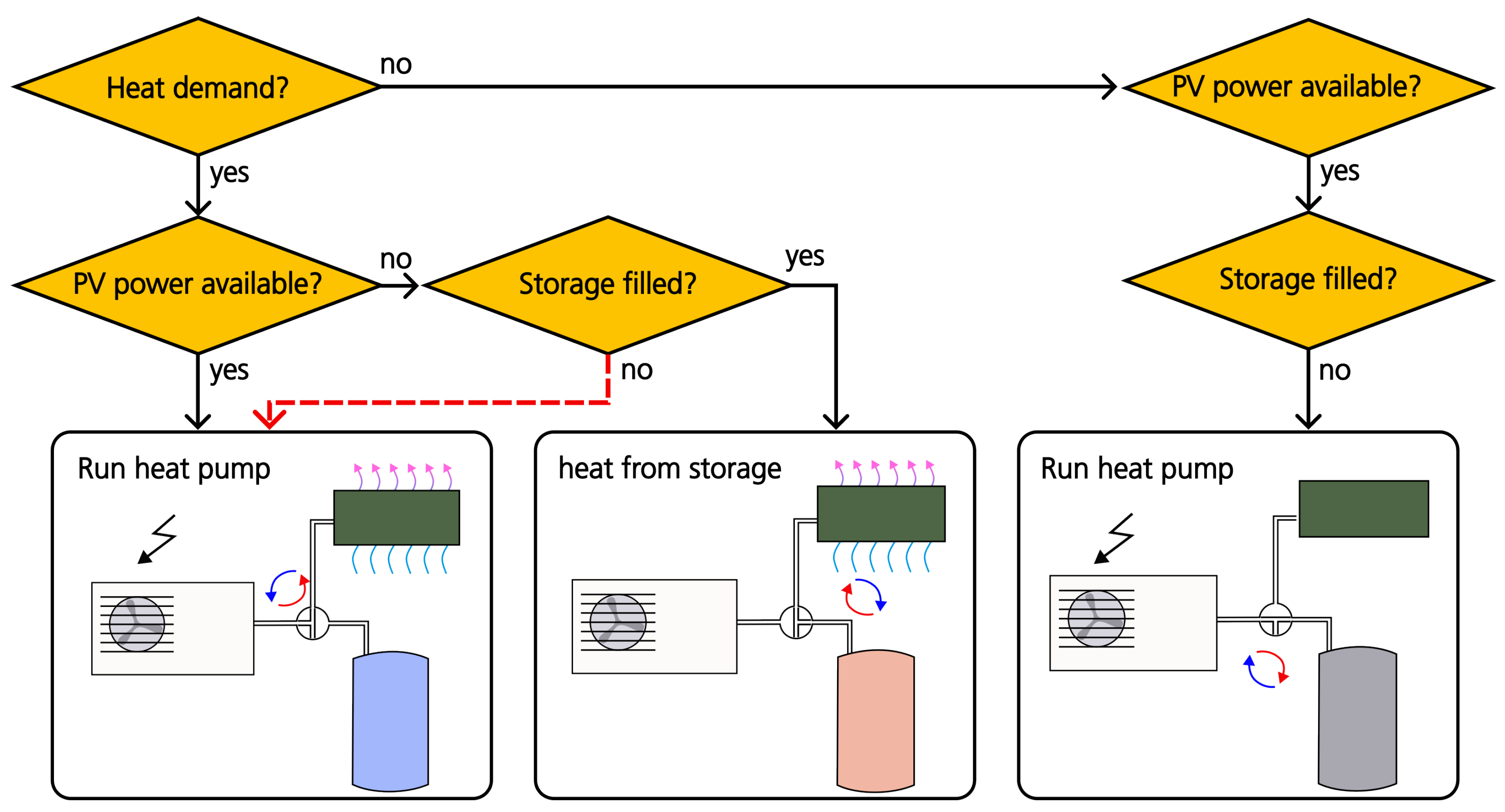

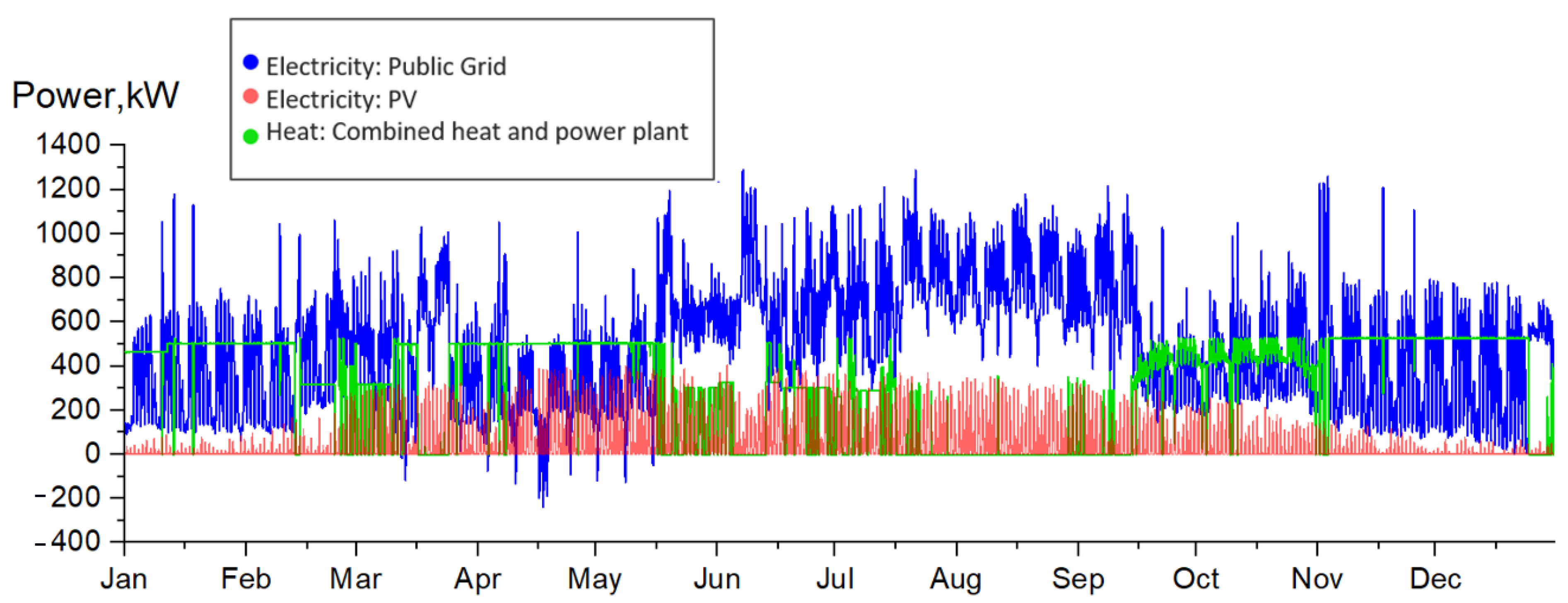
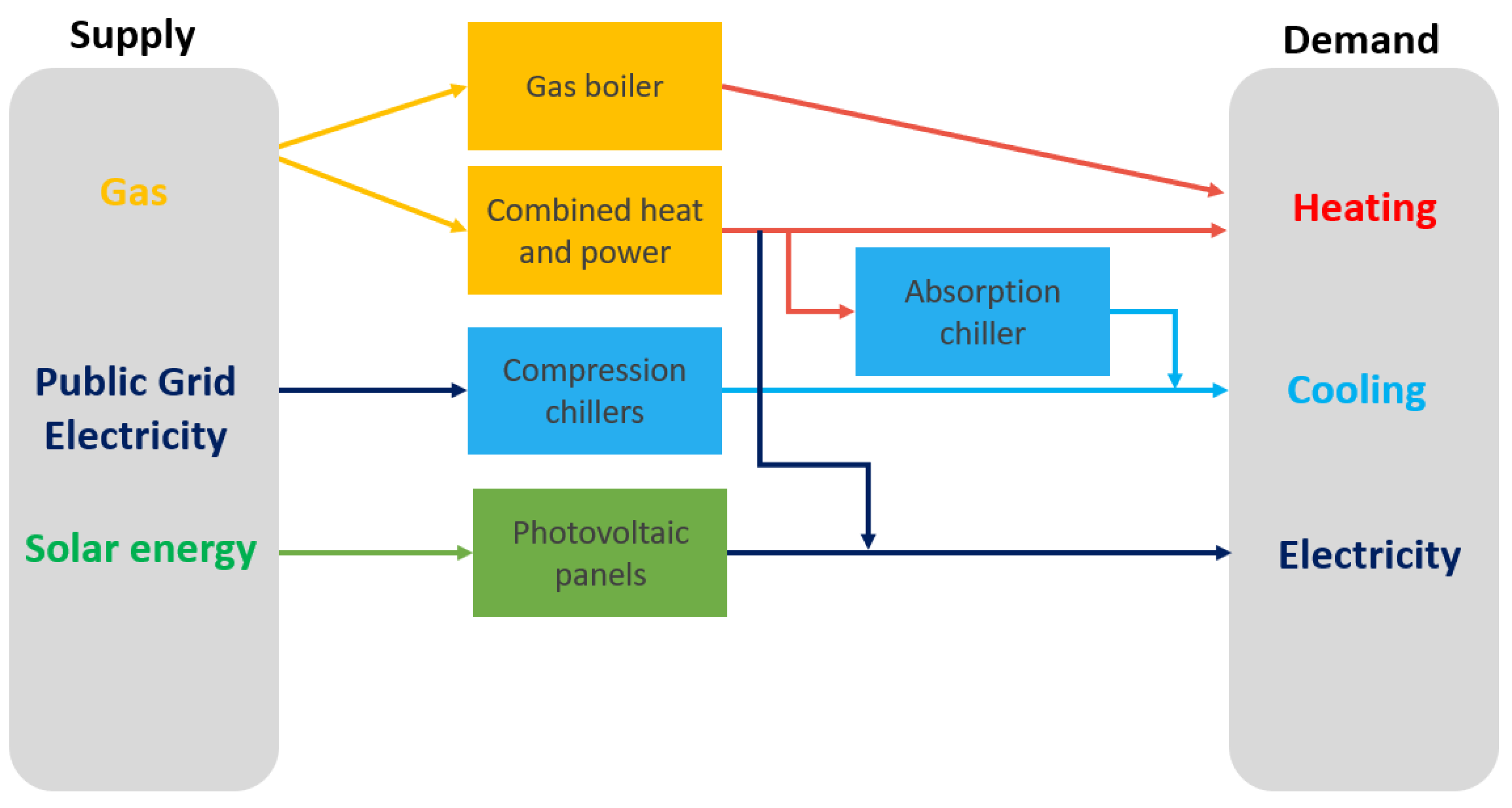
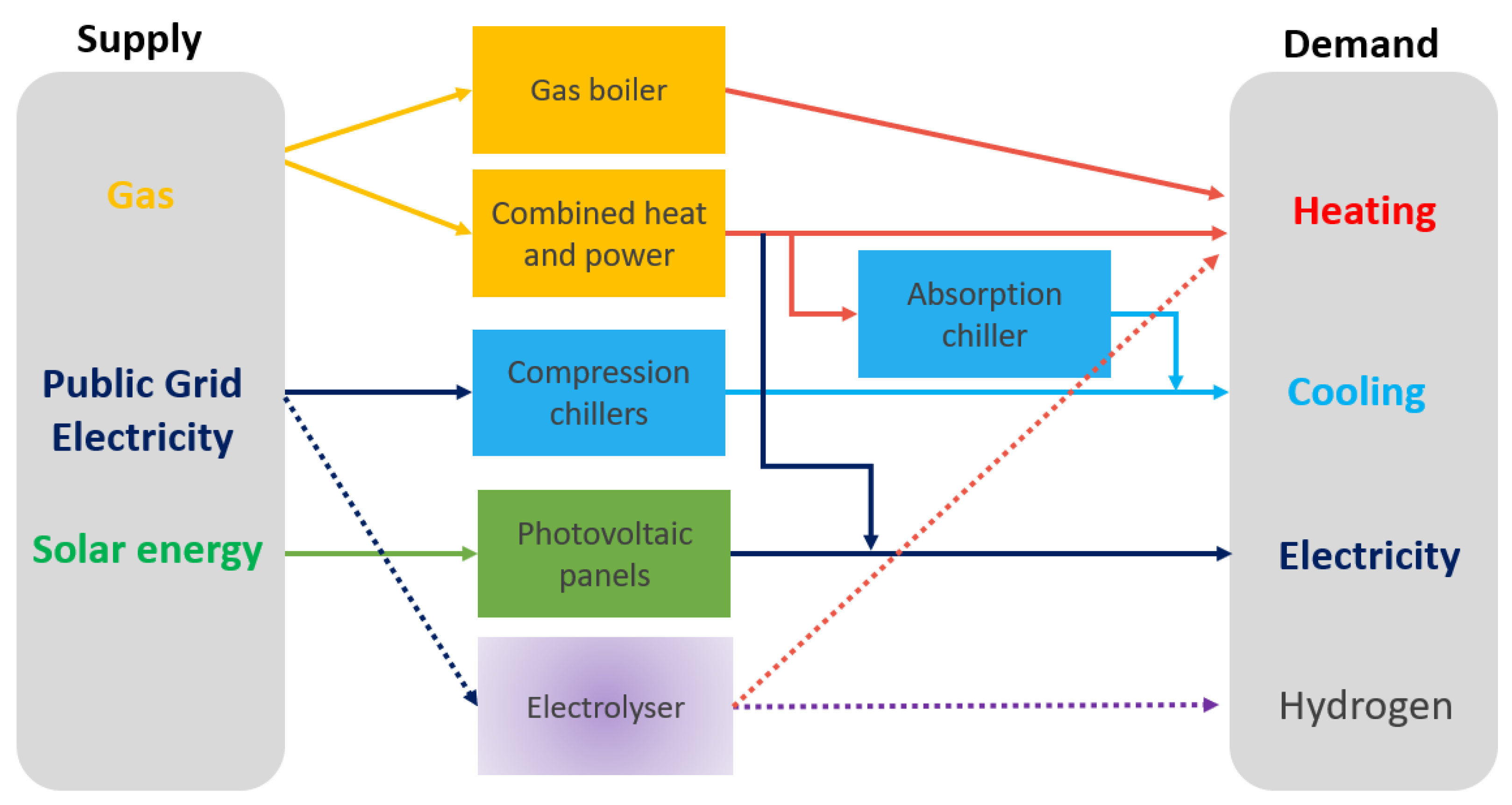
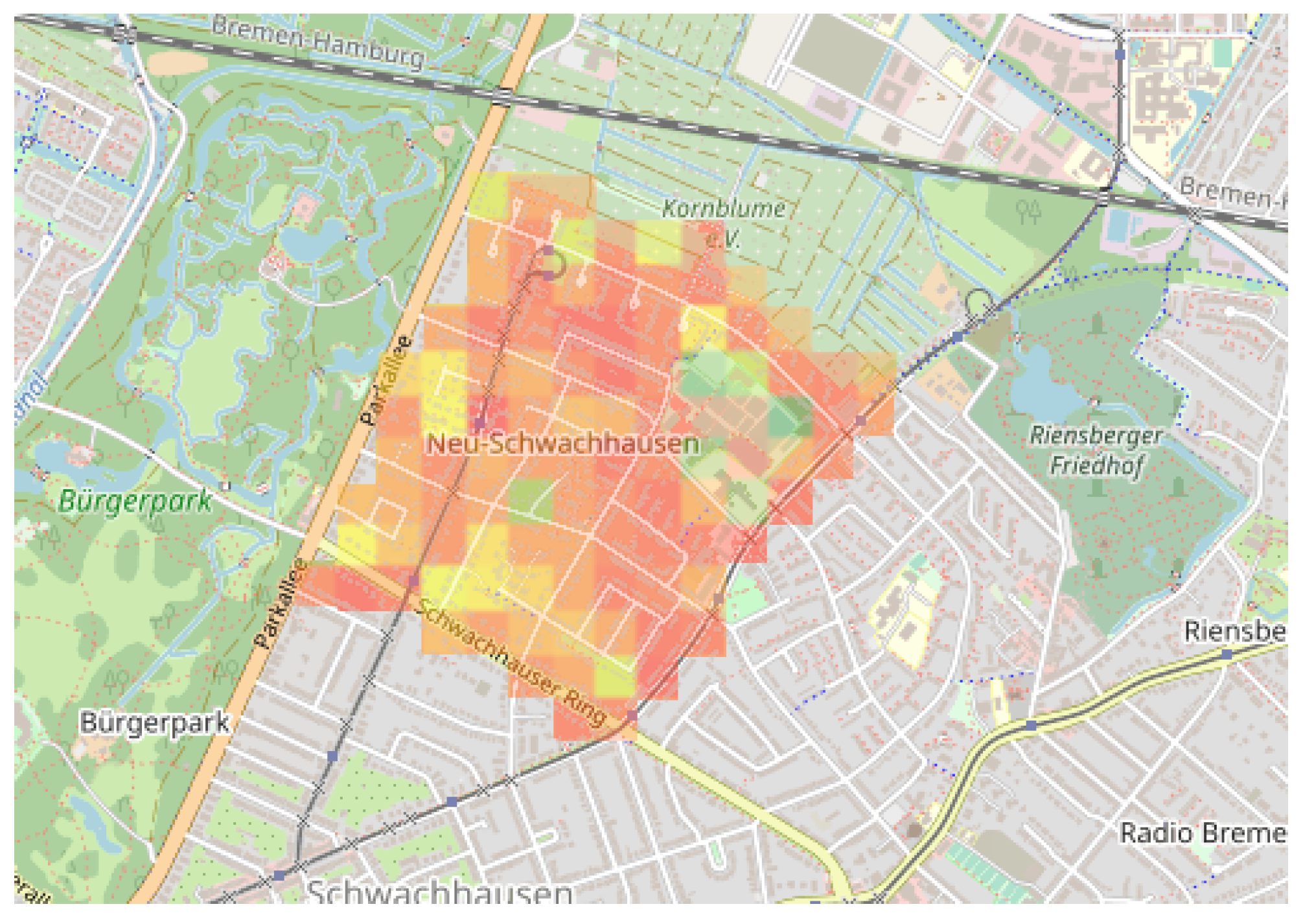
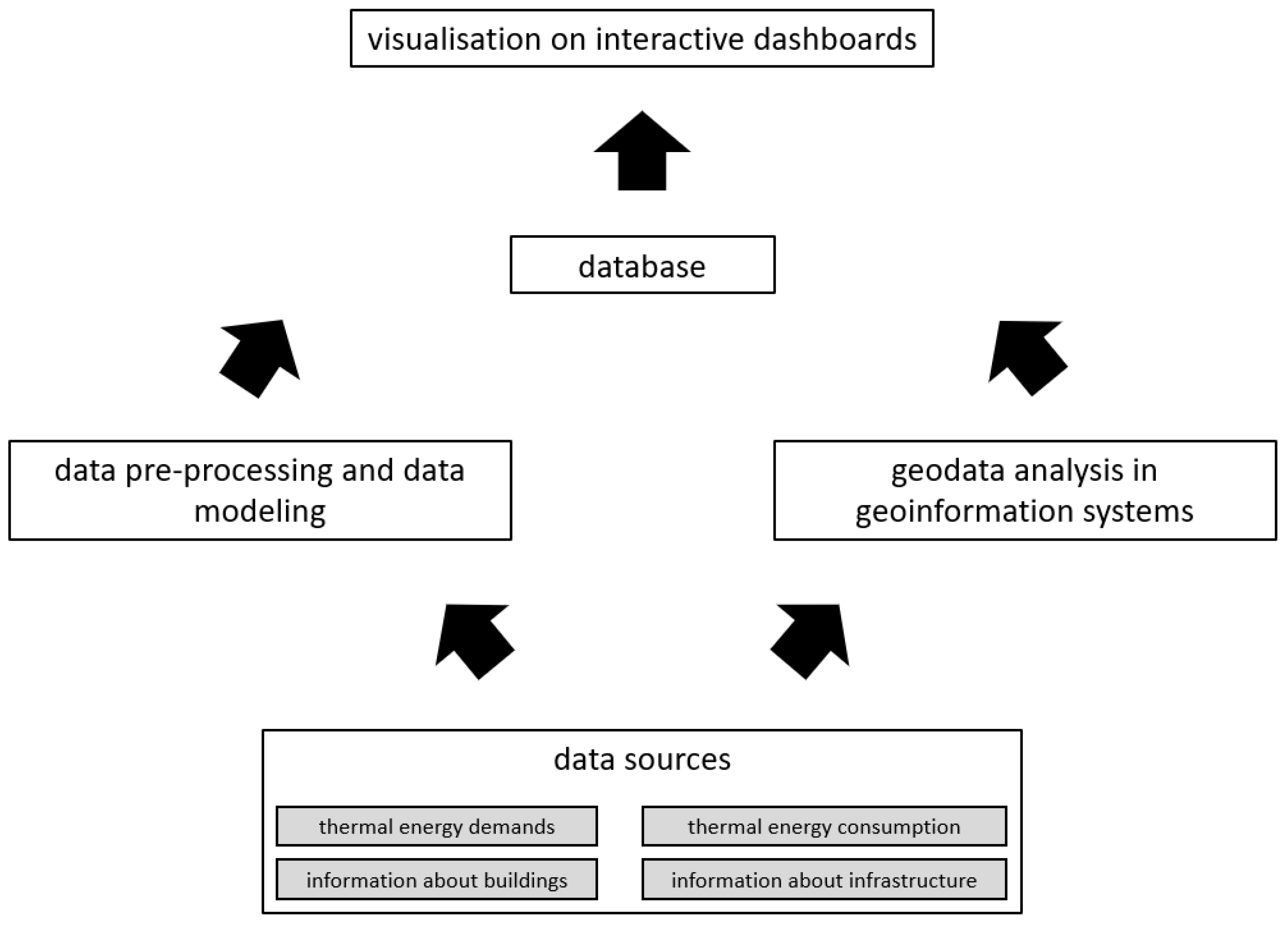
Disclaimer/Publisher’s Note: The statements, opinions and data contained in all publications are solely those of the individual author(s) and contributor(s) and not of MDPI and/or the editor(s). MDPI and/or the editor(s) disclaim responsibility for any injury to people or property resulting from any ideas, methods, instructions or products referred to in the content. |
© 2023 by the authors. Licensee MDPI, Basel, Switzerland. This article is an open access article distributed under the terms and conditions of the Creative Commons Attribution (CC BY) license (https://creativecommons.org/licenses/by/4.0/).
Share and Cite
Lesnyak, E.; Belkot, T.; Hurka, J.; Hörding, J.P.; Kuhlmann, L.; Paulau, P.; Schnabel, M.; Schönfeldt, P.; Middelberg, J. Applied Digital Twin Concepts Contributing to Heat Transition in Building, Campus, Neighborhood, and Urban Scale. Big Data Cogn. Comput. 2023, 7, 145. https://doi.org/10.3390/bdcc7030145
Lesnyak E, Belkot T, Hurka J, Hörding JP, Kuhlmann L, Paulau P, Schnabel M, Schönfeldt P, Middelberg J. Applied Digital Twin Concepts Contributing to Heat Transition in Building, Campus, Neighborhood, and Urban Scale. Big Data and Cognitive Computing. 2023; 7(3):145. https://doi.org/10.3390/bdcc7030145
Chicago/Turabian StyleLesnyak, Ekaterina, Tabea Belkot, Johannes Hurka, Jan Philipp Hörding, Lea Kuhlmann, Pavel Paulau, Marvin Schnabel, Patrik Schönfeldt, and Jan Middelberg. 2023. "Applied Digital Twin Concepts Contributing to Heat Transition in Building, Campus, Neighborhood, and Urban Scale" Big Data and Cognitive Computing 7, no. 3: 145. https://doi.org/10.3390/bdcc7030145
APA StyleLesnyak, E., Belkot, T., Hurka, J., Hörding, J. P., Kuhlmann, L., Paulau, P., Schnabel, M., Schönfeldt, P., & Middelberg, J. (2023). Applied Digital Twin Concepts Contributing to Heat Transition in Building, Campus, Neighborhood, and Urban Scale. Big Data and Cognitive Computing, 7(3), 145. https://doi.org/10.3390/bdcc7030145






